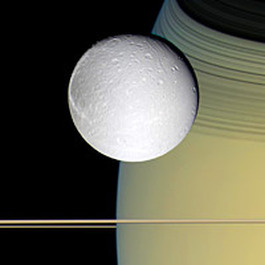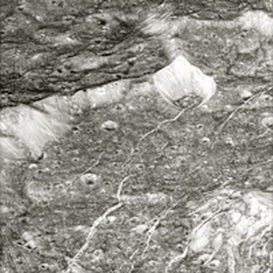Our Solar System
Dione

Dione is a small moon of 1,123 km (698 miles) in diameter orbiting Saturn every 2.7 Earth days at a distance of 377,400 km (234,000 miles), which is roughly the same distance that the Moon orbits around the Earth. Dione's density is 1.48 times that of liquid water, suggesting that about a third of Dione is made up of a dense core (probably silicate rock) with the remainder of its material being ice. At Dione's average temperature of -121 degrees Fahrenheit (-186 degrees Celsius or 87 kelvins), ice is very hard and behaves like rock.
As with Earth's Moon, Dione is phase locked with its parent; one side always faces toward Saturn. Likewise, Dione has gravitationally locked two much smaller moons: Helene orbits Saturn 60 degrees ahead of Dione, and Polydeuces orbits Saturn 60 degrees behind Dione. (These tidally locked moon locations are also referred to as Lagrange points, L4 for the leading spot and L5 for the trailing spot, based on calculations of the French astronomer Joseph-Louis Lagrange in 1772.)
As with Earth's Moon, Dione is phase locked with its parent; one side always faces toward Saturn. Likewise, Dione has gravitationally locked two much smaller moons: Helene orbits Saturn 60 degrees ahead of Dione, and Polydeuces orbits Saturn 60 degrees behind Dione. (These tidally locked moon locations are also referred to as Lagrange points, L4 for the leading spot and L5 for the trailing spot, based on calculations of the French astronomer Joseph-Louis Lagrange in 1772.)
A Desolate Ice world

Dione is the densest of Saturn's moons with the exception of Titan. It is composed mainly of water ice, but must contain a larger amount of rocky material than Saturn's other ice moons, Tethys and Rhea. Dione is very similar to Rhea in composition, although somewhat smaller. Dione is believed to have a rocky core with less ice coverage than Rhea
Features of Dione

Dione is locked in a synchronous orbit similar to that of Rhea. This causes the same face of the moon to point towards Saturn at all times. Dione has similar albedo features and terrain to that of its close cousin, Rhea. Dione's surface consists of heavily cratered areas, moderate and lightly cratered plains, and bright, wispy features. Most of the heavily cratered areas exist on the trailing hemisphere of the moon. Some of these craters exceed 62 miles (100 km) in diameter, while most of the craters in the plains areas are less than 18 miles (30 km) in diameter. The largest crater is called Amata and is 150 miles (241 km) in diameter. Like Rhea, these craters lack the high relief features seen on Mercury and the Moon. Heavy cratering would normally be expected on the leading edge of a tidally locked satellite.
Since most of Dione's craters are located on the trailing hemisphere, astronomers believe that Rhea may have once been tidally locked with Saturn in the opposite orientation. Since Dione is relatively small, it would have only taken an impact leaving a 21-mile (35 km) crater to spin the moon around. With many craters on Dione exceeding 21 miles, it is possible that the moon has been spun around more than once throughout its long history. The origin of the bright, wispy streaks is not known. The streaks overlay many of the craters, which indicates that they are newer. They may have been formed by ice eruptions through cracks in the surface. This material may have fallen back to the surface as snow or ash. Dione has no detectable atmosphere.
Since most of Dione's craters are located on the trailing hemisphere, astronomers believe that Rhea may have once been tidally locked with Saturn in the opposite orientation. Since Dione is relatively small, it would have only taken an impact leaving a 21-mile (35 km) crater to spin the moon around. With many craters on Dione exceeding 21 miles, it is possible that the moon has been spun around more than once throughout its long history. The origin of the bright, wispy streaks is not known. The streaks overlay many of the craters, which indicates that they are newer. They may have been formed by ice eruptions through cracks in the surface. This material may have fallen back to the surface as snow or ash. Dione has no detectable atmosphere.
Statistics for Dione
Discovered by - Giovanni Cassini
Year of Discovery - 1684
Diameter - 697.8 miles (1,123 km)
Mean Distance from Saturn - 234,567 miles (377,400 km)
Rotational Period - 2.74 Days
Orbital Period - 2.74 Days
Orbital Eccentricity - 0.0022
Orbital Inclination - 0.02 degrees
Mean Surface Temperature - -303 F (-186 C)
Main Atmospheric Component - None
Apparent Magnitude - 10.4
Year of Discovery - 1684
Diameter - 697.8 miles (1,123 km)
Mean Distance from Saturn - 234,567 miles (377,400 km)
Rotational Period - 2.74 Days
Orbital Period - 2.74 Days
Orbital Eccentricity - 0.0022
Orbital Inclination - 0.02 degrees
Mean Surface Temperature - -303 F (-186 C)
Main Atmospheric Component - None
Apparent Magnitude - 10.4
